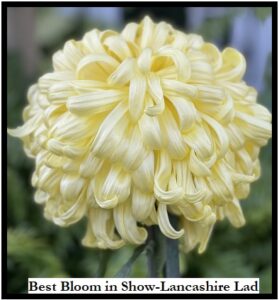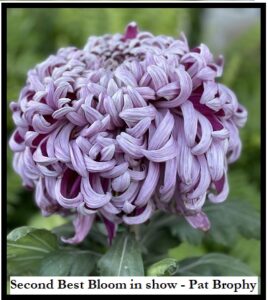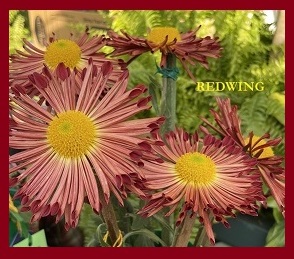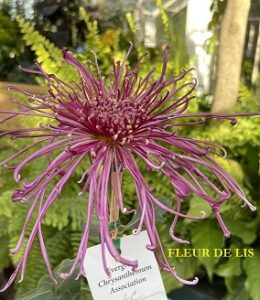MEETING OF THE ECA – THURSDAY September 10th , 2009 at 7 PM at the Seattle Police Athletic Association Office (SPAA) site at 11030 East Marginal Way South, Tukwila.
TELEPHONE COMMITTEE MEMBERS call your lists early as your calls do help to increase attendance.
ANNUAL GARDEN TOUR – The annual garden tour and picnic was Sunday August 8th.
The tour viewed a variety of gardens with many Chrysanthemums. It turned out to be a nice day. The tour visited the gardens of Bob and Mary Lou Ewing (who supplied refreshments to help us wake up). Many thanks to Don and Jane Stark for letting us see how their chrysanthemums are doing, the tour concluded with a potluck picnic at Rich and Julie Pozniak’s beautiful home. It was a great picnic; thanks to the Pozniak’s hospitality and all who brought such delicious dishes for everyone to enjoy. We had 19 members in attendance. A good time was had by all.. Thanks also to Steve Backstrom for giving me driving directions to the Pozniak’s and also thanks to Don Stark for their directions as well.
Special Thanks to the members who opened their gardens for us to tour, it was a pleasure. Special Thanks to Rich and Julie Pozniak for Hosting the Picnic. I would like to also express Our Thanks to Jack Brandon for coordinating the telephone tree helpers and notifying members of the events; this contributed to our great turn out for the garden tour and picnic. Many Thanks to all the great cooks.
For those who already have mature blooms, consider entering them in the Puyallup Fair. For information about the fair, go to www.thefair.com on the internet. Select Entries and Floral and the Chrysanthemum section to obtain the Puyallup Fair Show Schedule. Those exhibiting at the fair get free admittance to the fair for the day.
SEPTEMBER MEETING: This is a very important meeting as we begin to prepare for our annual show October 24th and 25th (Set-up Wed. Oct. 21st). Judging Friday Oct. 23rd at Furney’s Nursery, 21215 International, Blvd. and Pacific Hwy. S.
Just a reminder that the Aki Matsuri (Fall Festival) will be held September 12th and 13th at Bellevue Community College. Our club is having an exhibit there. Maybe some of our ECA members will have some blooms to show off there.
LOOKING FORWARD TO SEEING EVERYONE AT THE MEETING, IF RIDES ARE NEEDED PLEASE CALL SOMEONE LIVING IN YOUR AREA.
PLANT CULTURE and SUPPLIES: – The September meeting will devote time to the care and feeding of the blooms as they develop; Club supplies will be available, place orders for specific items with Don Stark. Cultural recommendations are attached. With possible rain or showers consider your sheltering options for September as we move to the latter part of the growing season.
SEPTEMBER TO DO LIST – (adapted from Don Stark 9/98 notes)
Once the buds have broken the membrane and some petal tips are showing, it is time to get the pots into or under some kind of shelter. The basic idea is to protect the blooms from rain and dew. If rain or dew is present when the sun strikes, you will almost certainly burn the florets. Shelters come in a variety of sizes, names, and shapes including porches, large overhanging eaves, garages, greenhouses, and temporary wood and plastic structures.
Sheltering Plants During the Bloom Cycle Starting September 1
• Shelter requirements are daytime light (though it can be shady), ventilation, and temperature control.
• Maximum temperature should be kept below 80 degrees F if possible. Above that temperature the probability of bloom damage due to petal rot is high. If the shelter is exposed to too much sun in the early Sept days, the temperature within the shelter can skyrocket.
• Big fans keep the air moving and the temperature down. Fans also hopefully can bring air from a shady side of the shelter to cool the overall area as well.
• Lining the inside of the shelter with old sheets or muslin will also reduce the heat and filter the sunlight.
Bring Pots Into Cover
• Wash the pots to get rid of the crud and residue from the growing area.
• Pick off old dead and damaged leaves (mostly at the bottom of the plant) that harbor pests and fungus.
• Spray the plant with a fungicide and insecticide before taking to the shelter.
• Watch for and destroy earwigs. They wreck blooms when they get inside.
• Top-dress the pots again. Put about ½ to ¾” of the 9-Inch mix or Soilless mix on the surface of the pot and level it. Top-dressing the plants helps finish plant growth now and also promotes shoots on the plant stools for our next growing season.
• Optionally, add ¼ teaspoon FeSo4 to enhance color. Do not add to plants with white or yellow blooms.
• Add ¼ teaspoon of Potash to help harden off the plant and keep the blooms from being too soft.
Plant Clean Up and Cut Back to Final Lateral Count
• As the plant goes to shelter, if not already done, cut back to the final lateral count selecting the best overall laterals. For #1’s keep 1 or 2 blooms per plant, #2’s keep 2 blooms per plant, #3’s and others excluding specimen plants keep 2 to 5 blooms per plant.
• Stake and tie up the selected laterals and add support shingles for the blooms as you house the plant.
• Remove or pick off the side laterals on the selected stems.
Fertilizing & Watering
• For late season fertilizing, reduce fertilizer to ½ strength for 2-3 weeks. After the petals start to fall, gradually increase feed. Switch to a higher potash fertilizer along the lines of a 15-10-30 or other bloom feeder fertilizer and go lightly.
• Watering is different at this stage as the plants are kept a little dryer at this stage. Water plants more sparingly, using about 1 pint per watering. Do not water when the temperature exceeds 75F.
• There are two schools of thought as to the best time of day to water. Previous year cultural notes recommend to water in the evening as the day is cooling down to help avoid sending the plant sap to the blooms in heat of day and blowing out or cracking the bloom neck. Bob Walker recommends watering in the early part of the day.
• Water/fertilize from a bucket using a 1-pint jar or similar small container. Do not use the hose and spread water everywhere on the shelter floor. Keep the finishing area dry and clean.




